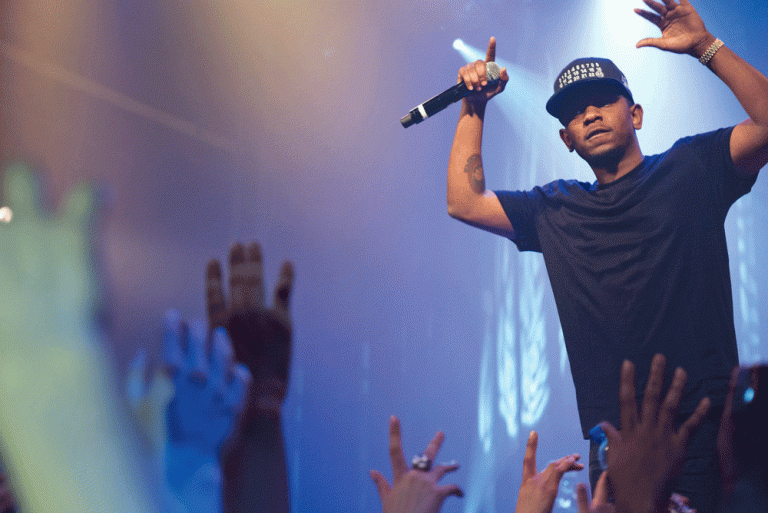
Jeremy Levine
Copy Editor
Kendrick Lamar is the greatest storyteller rap has ever seen. Good Kid M.A.A.D. City’s cinematic coming-of-age story of his childhood in Compton elevated him to superstar status in 2012. In 2015, To Pimp A Butterfly changed the face of rap: an epic production team provided a live instrumentation-heavy backdrop for Kendrick to discuss his conflicts with fame, identity, and community and compare them within the larger context of the African-American experience. Within another year, he released Untitled Unmastered, an eight-track mixtape that would have been a notable achievement for any other rapper. For Kendrick, it was merely a collection of throwaways from TPAB.
Kendrick shows no signs of letting up. He warned with the release of “The Heart Part IV” on Mar. 23 that “ya’ll got till April the 7th to get your shit together,” hinting at an album. He actually meant “ya’ll got until April the 7th to get ready to get your shit together on April the 14th, when my album will actually come out,” since he made fans wait an extra week. Despite the extra time, the world still collectively did not have its shit together when Damn. was released last Friday.
These are the words of a haunted prophet trapped in a cycle of temptation, at least on this earth. The album begins with “BLOOD.,” a monologue concluding in Kendrick losing his life. What follows is different from Kendrick’s past albums, without a story arc in the traditional sense. Instead, each track feels like you are in a different part of Kendrick’s head, a frantic stream-of-consciousness from the greatest rapper alive.
He details his battle with the devil on “YAH.,” singing in a delicate croon, “I know he walks the Earth / But it’s money to get, bitches to hit, yah / Zeroes to flip, temptation is yah / First on my list, I can’t resist, yah.” We’ve been here before: Kendrick battled the same temptation on TPAB with the Devil, dubbed Lucy.
He acknowledges that giving in to temptation is nothing new on “LUST.,”: “I wake in the mornin’, my head spinnin’ from the last night / Both in the trance, feelings I did, what a fast life / Manager called, the lobby called, it’s 11:30 / Did this before, promised myself I’d be a hour early / Room full of clothes, bag full of money, call it loose change / Fumbled my jewelry, 100k, I lost a new chain / Hop on the bird, hit the next city for another M / Take me a F and do it again.” The production is the sound of the feeling you get when you’re drunk and horny and stand up too fast; Kendrick’s singing is at an impossible, goosebump-inducing falsetto, conveying his desperation as, “Blood rush to my favorite vein / heartbeat racing like a junky.”
Losing his temper is another recurring aspect of Kendrick’s temptation, and on Damn. he feels close to snapping. He threatens to kill, or at least expresses a willingness to do so, on “DNA.,” “ELEMENT.,” “XXX.,” and “FEAR.” Kendrick is at his most gangster with fighting words like, “I’ll chip a nigga, then throw the blower in his lap / Walk myself to the court like, ‘Bitch, I did that!’” on “XXX.,” running lyrical laps around a sine-wave bass line and chilling sirens.
Not all violence in the album is gangster, however. Kendrick uses it to denounce his celebrated public status after a friend asks him how to respond to the friend’s son being killed: “He said: ‘K-Dot, can you pray for me?’ / It’s been a fucked up day for me / I know that you anointed, show me how to overcome’ / He was lookin’ for some closure / Hopin’ I could bring him closer / To the spiritual, my spirit do no better, but I told him / ‘I can’t sugarcoat the answer for you, this is how I feel: / If somebody kill my son, that mean somebody gettin’ killed.’” Throughout Damn., Kendrick questions his qualifications as a role model because of his temper. Here, it sounds like he’s fiending for a shootout.
Yet, he also seems obsessed with life and his legacy: “What happens on earth stays on earth” booms at the beginning of a few tracks. On “FEAR.,” which ties the album together around Kendrick’s fears, he laments, “I’m talkin’ fear, fear that it’s wickedness or weakness / Fear, whatever it is, both is distinctive / Fear, what happens on Earth stays on Earth / And I can’t take these feelings with me / So hopefully they disperse.” The finality of death haunts Kendrick, and he’s uncertain he can come to peace with himself before that moment.
“The coincidence of his life doesn’t matter in the face of the coincidence of his death.”
In Kendrick’s uncertainty, he finds his Tupac moment. Like Tupac did, Kendrick is struggling to reconcile his nature — his DNA — with his belief in himself as a savior for his community. On “FEEL.,” he raps, “I feel like this gotta be the feelin’ what Pac was / The feelin’ of an apocalypse happenin’, but nothin’ is awkward.” Insecurity and paranoia consume Kendrick in much the same way they did in Pac’s final days. He worries “ain’t nobody praying for me,” and “I feel like friends been overrated / I feel like the family been fakin’,” throwing everyone into doubt. His increasingly violent inclinations also reminisce of Pac, who spit his most violently inciteful lyrics shortly before his death.
On GKMC, Kendrick conquered his temptation by becoming a “real” role model for his community; TPAB saw him confront his distance from his home by returning to it; but the temptation to do evil is still there, unconquered and unconquerable. The closest Kendrick comes to discussing reconciliation with life on the streets is “DUCKWORTH.,” which is only indirectly about him. Over a body-melting 9th Wonder-produced medley of boom-bap drums and Yugoslavian vocal samples, it starts with Kendrick musing to himself before launching into a three-minute tale about Anthony, “the oldest of seven / Well-respected, calm and collected” who “was meant to be dangerous.” It’s an epic street legend from a rapper who became famous with a street legend, GKMC. The tale of Anthony turns out to be the life story of Anthony “Top Dawg” Tiffith, Kendrick’s mentor and record label-head, and a coincidental run-in with Kendrick’s father (Ducky in the song), who worked at a KFC that Anthony had robbed and shot the cashier at in the past. Anthony’s decision to let Ducky live during another robbery enabled Kendrick to grow up and eventually sign onto Anthony’s label, Top Dawg Entertainment (they didn’t find out about their run-in until years later).
While the story of Anthony and Ducky itself is incredible, its conclusion is dark. In the plot-twist climax — “Whoever thought the greatest rapper would be from coincidence? / Because if Anthony killed Ducky / Top Dawg could be servin’ life / While I grew up without a father and die in a gunfight” — Kendrick reflects on the coincidence of his entire life path. However, the song doesn’t simply end there; there is a gunshot bang, about 20 seconds of a rewinding sound effect, and then the words “I got, I got, I got” from the beginning of DNA and “so I was taking a walk the other day” from the monologue in BLOOD.
There are two grim implications here. First, despite not dying in a gunfight because he had no father figure, Kendrick is shot anyways. The coincidence of his life doesn’t matter in the face of the coincidence of his death. Second, that the only way to escape the cycle of turmoil and temptation in the first place is death anyways.
Damn. lacks the definitive upbeat moments of GKMC and TPAB, but if there is any response to these bleak conclusions, it is the Black Israelite movement, which supports the idea that indigenous Americans and black people are the lost tribes of Israel. Kendrick first references it in “YAH.” when he says, “I’m an Israelite, don’t call me black no mo’ / The word is only a color, it ain’t fact no’ mo.’”
His cousin elaborates on the introduction of fear with a voicemail that says, “We are a cursed people. Deuteronomy 28:28 says, ‘The Lord shall smite thee with madness, and blindness, and astonishment of heart.’ See, family, that’s why you feel like you feel like you got a chip on your shoulder. Until you finally get the memo, you will always feel that way.” Kendrick is not lustful, temperamental, untrusting, or self-doubting because of outside forces as it appeared on GKMC, or internal failures, as it appeared on TPAB, but rather because it is a curse in Kendrick’s blood — his DNA.
Although it sounds like a classic brag track when standing alone, “DNA.” acquires new, literal meaning when heard from the Black Israelite perspective. “Tell me when destruction gonna be my fate / Gonna be your fate, gonna be our faith / Peace to the world, let it rotate / Sex, money, murder — our DNA,” the final words of the song, become an existential question posed to a god Kendrick believes has cursed him.
The music video for DNA, which came out four days after Damn., adds another layer of meaning. It opens with Kendrick sitting in a jail cell as “YAH.” plays almost inaudibly in the background, possibly Kendrick’s final internal contemplation of his battle with the devil’s temptations. An interrogator enters and informs Kendrick that DNA stands for “Dead Nigga Association” before Kendrick possesses him, raps the first verse, and breaks from the prison of his inner conflict to return to the streets. As the handcuffs come off of him, the video flashes to clips playing “Hood Politics,” a song off of TPAB about Kendrick’s continued engagement with the street politics of his hood.
I think it means that Kendrick not only can’t escape his temptations, but he can’t escape Compton. Besides being filled with iconic scenes like Kendrick grimly holding his baby daughter or dodging paparazzi cameras, the second verse shows Kendrick playing dice in the street with (presumably) his homies. If there’s anything close to a satisfying resolution to be found, it’s that Kendrick seems satisfied, or at least resigned, to his fate. Remember to pray for him.
















